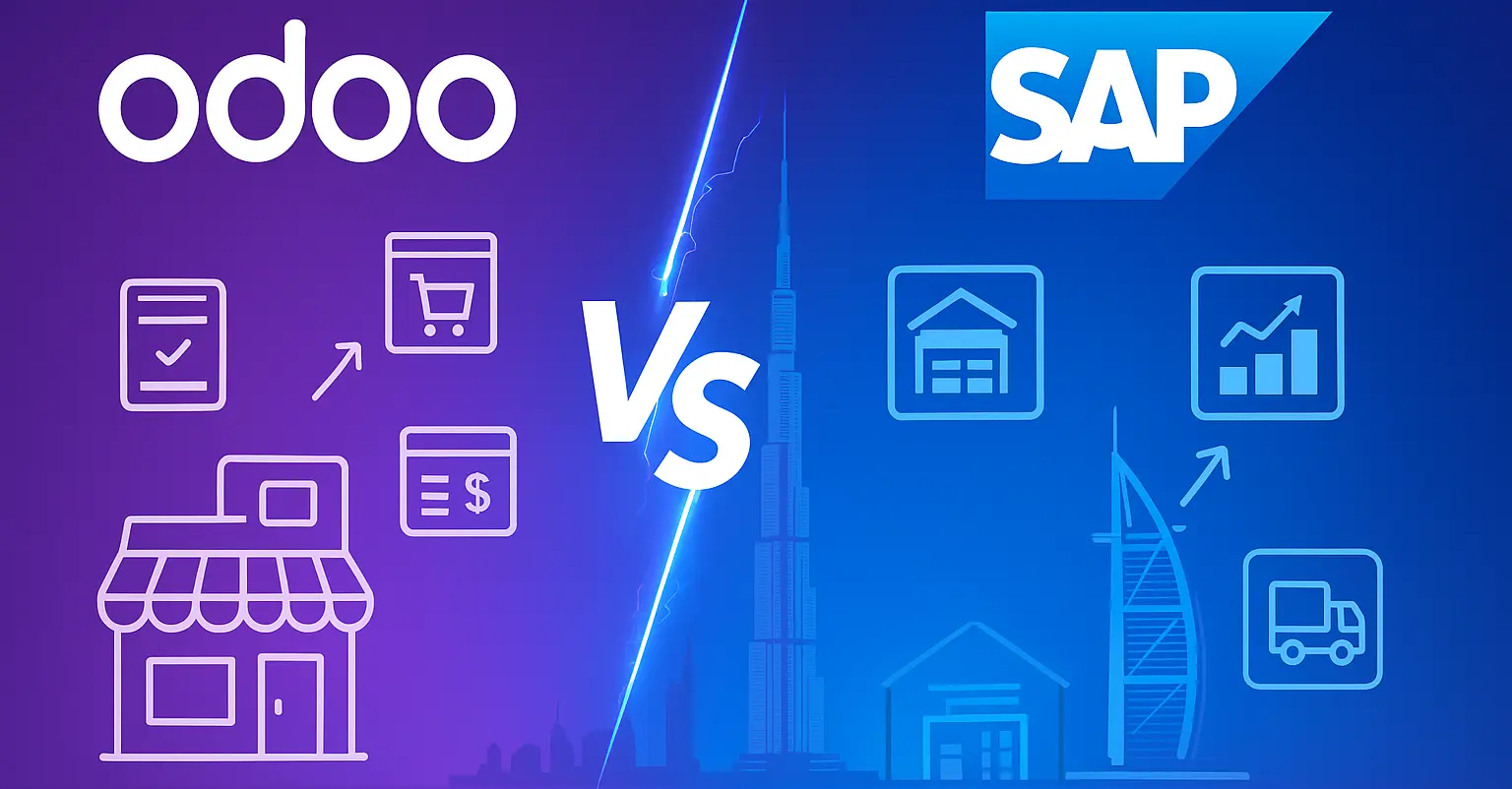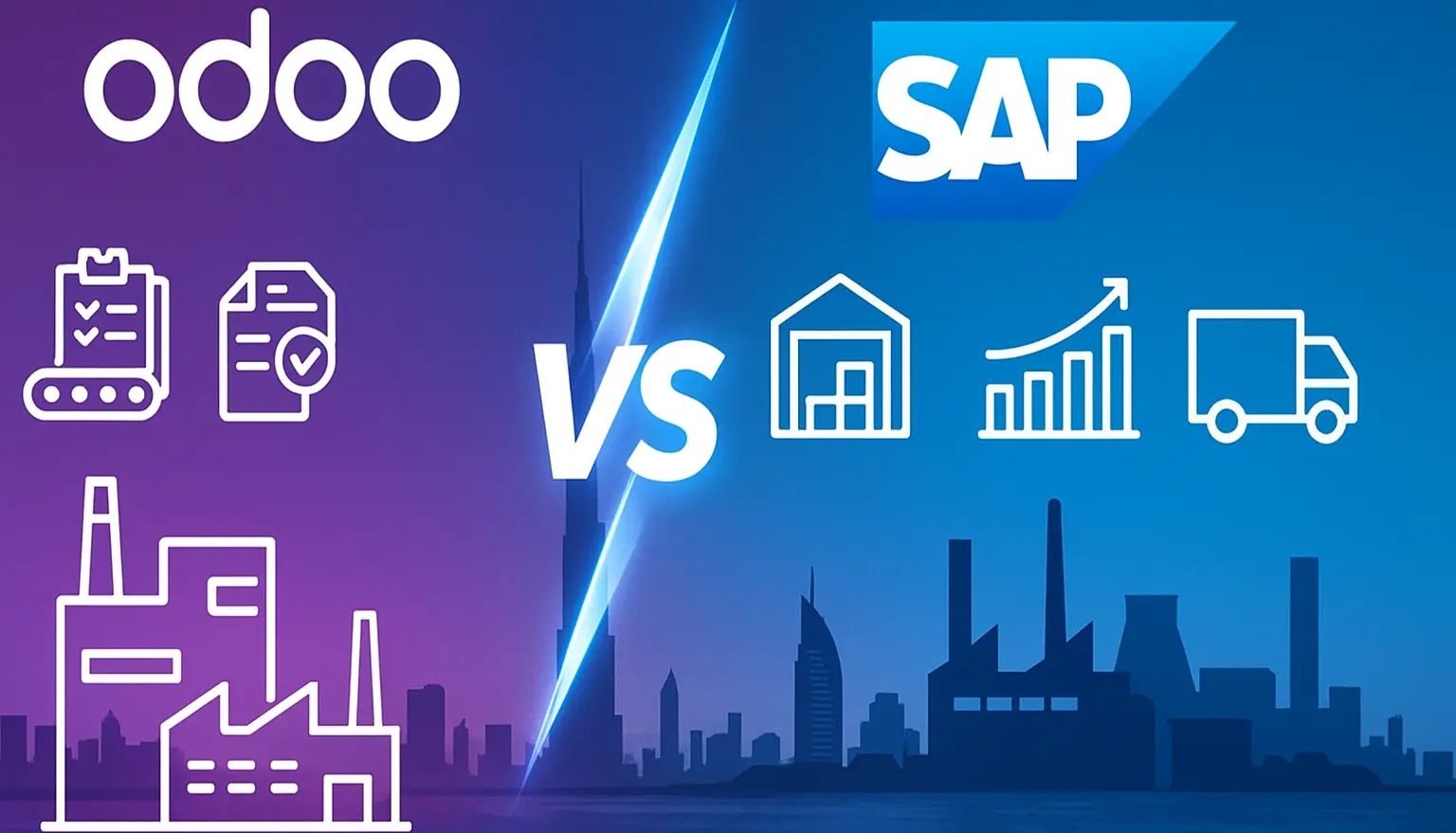For decades, the name SAP has been synonymous with enterprise-grade ERP. For many C-level executives and IT managers in the GCC, it has long been the “safe bet.” But what if the safe bet is no longer the smartest one especially for agile, fast-growing SMEs in markets like the UAE and Saudi Arabia?
As an official Odoo Partner in the GCC, SSD4Me has seen the conversation shift. In today’s fast-paced business environment, where speed, flexibility, and cost-efficiency are critical, Odoo isn’t just an alternative it’s becoming the strategic choice.
This blog compares Odoo vs SAP Business One with GCC-focused case studies, global benchmarks, and market data—so you can make an informed decision for your business.
Odoo vs SAP ERP Cost in GCC: Total Cost of Ownership (TCO)
When selecting an ERP, you’re not simply buying software you’re investing in a long-term business partner. The Total Cost of Ownership (TCO) includes licenses, implementation, customization, training, maintenance, and upgrades.
- SAP Business One: High upfront licensing fees, lengthy implementation (6–12+ months), and annual maintenance costs that can exceed hundreds of thousands of dirhams (SAP Business One Overview).
- Odoo Enterprise: Transparent per-user, subscription model. Pay only for what you need, with faster go-lives and predictable subscription costs (Odoo Pricing).
According to Top10ERP.org, businesses typically spend 1–3% of their annual revenue on ERP implementation. For SMEs in the GCC, this makes Odoo’s modular, cloud-first approach far more affordable and sustainable than SAP.
Case Study 1: Odoo vs SAP for a Retail & E-commerce Business in Dubai, UAE

A mid-sized Dubai retailer with 15 employees was running separate systems for accounting, POS, and e-commerce. They needed one unified ERP.
| Feature/Cost | SAP Business One | Odoo Enterprise | The Verdict |
| Implementation Time | 6–8 months | 3–4 months | Odoo wins – faster ROI |
| Estimated Upfront Cost | AED 150K–250K | AED 45K–65K | Odoo wins – lower investment |
| Annual Maintenance | ~20% of license + consulting fees | Subscription covers updates | Odoo wins – predictable |
| Key Functionality | Needs 3rd-party API for e-commerce | Native e-commerce + PayTabs / Stripe integration | Odoo wins – seamless omni-channel |
Key Takeaway: Odoo’s native integration eliminated complex third-party connectors, simplifying operations and cutting costs.
Case Study 2: Odoo vs SAP for a Manufacturing SME in Jeddah, Saudi Arabia

A 25-employee manufacturer in Jeddah producing building materials needed ERP for end-to-end production management.
| Feature/Cost | SAP Business One | Odoo Enterprise | The Verdict |
| Implementation Time | 8–12 months | 4–6 months | Odoo wins – faster time-to-value |
| Estimated Upfront Cost | SAR 200K–350K | SAR 75K–100K | Odoo wins – fraction of SAP cost |
| Key Functionality | Requires extensive customization | Flexible BoM, work orders, QC, adaptable | Odoo wins – agile manufacturing |
Global benchmarks show small businesses spend around US$9,000 per user on ERP implementation (ECI Solutions ERP Report). This Jeddah case shows how Odoo undercuts that average while delivering flexibility.
Key Takeaway: Odoo’s adaptability allowed precise tailoring of multi-level BoMs and production flows, which SAP struggled to match without major custom development.
Odoo vs SAP Scalability for SMEs in GCC
“SAP is more scalable.” True for global multinationals, but scalability means something different for SMEs in GCC growing from 50 → 500 employees.
- SAP Business One: Adding modules is costly and often requires specialized consultants, slowing agility.
- Odoo Enterprise: Modular “App Store” model lets SMEs add apps (field service, new e-commerce, CRM) on demand (Odoo Apps).
According to Fortune Business Insights, 53% of enterprises in the Middle East & Africa have already adopted cloud ERP. This shift highlights the demand for scalable, flexible, cloud-native systems like Odoo.
ERP Localization in GCC: VAT, ZATCA & Free Zone Compliance
An ERP in the GCC must go beyond “translation.” It must handle tax, compliance, and regulations out of the box.
- SAP Business One: Localization packs exist but often require heavy consulting to adapt to UAE VAT (5%) or Saudi ZATCA e-invoicing.
-
Odoo Enterprise: GCC-specific modules from partners like SSD4Me ensure:
- VAT-ready reporting in UAE
- ZATCA-compliant e-invoicing in KSA
- Multi-currency & free zone reporting
The GCC ERP Software Market is projected to grow from USD 2.1B in 2023 to USD 5.6B by 2035, at a CAGR of 7.6%. This rapid expansion shows ERP adoption is no longer optional—it’s critical for competitiveness.
Why Odoo is the Best ERP for SMEs in UAE & Saudi Arabia
Choosing ERP is no longer about picking the most well-known brand. It’s about strategic fit, cost efficiency, and flexibility.
- SAP is ideal for rigid, global enterprises with deep budgets.
-
Odoo offers GCC SMEs:
- Lower TCO
- Faster implementation
- Greater flexibility & scalability
- Built-in GCC localization
Verdict: For most SMEs in GCC, Odoo is the smarter ERP choice.
Meet an Advisor Schedule a Demo